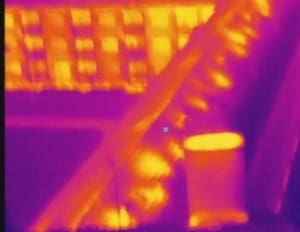
Thermal imaging cameras are used for building insulation inspections for decades. Thermographers over the world have discovered the advantage of using thermal imaging technology to map heat loss in buildings. Roofs can pose a problem, however. Not all roofs are easily accessible, so unless there are adjacent buildings that can serve as a vantage point it will be very difficult for the thermographer to inspect the roof. Using a helicopter would be the perfect solution, for this would allow the thermographer to look at the roof from a vantage point of his choice. Helicopters do not come cheap however, so the more affordable alternative is to use an unmanned aerial vehicle (UAV) with a built-in thermal imaging camera.
Ralf Grispen, of the Uden, Netherlands, based Thermografisch & Adviesbureau Uden and Peter te Velde from the Wijhe, Netherlands, based consultancy agency Jansen Venneboer have embraced this solution together. Test flights confirmed that this method is a viable solution for roof insulation inspections. “With the remote controlled copter you can cover the entire building, inspecting it from every possible angle” says Grispen. “This is a great addition to the regular ground based thermographic inspections.”
The copter used in the test flights is an octocopter, which means that it features eight rotors, from the manufacturer Draganfly. The Draganflyer X8, as it is called, uses an onboard processor and eleven onboard sensors (three gyros, three accelerometers, three magnetometers, one barometric sensor, and one GPS receiver) to enable it to stabilize and hover in place. This enables it to serve as a stable platform for camera systems, such as thermal imaging cameras from FLIR Systems.
Tau 320 thermal imaging camera core
The thermal imaging camera that is mounted on the octocopter is the Tau 320 thermal imaging camera core. This extremely light and compact camera core lends itself perfectly for integration with this type of UAV. Due to its low energy consumption, small size and modest weight it has little to no impact on the flight time of the UAV.